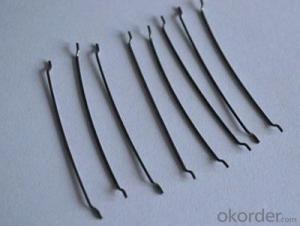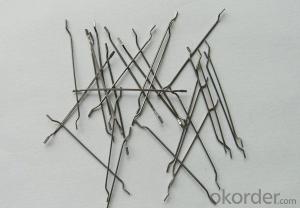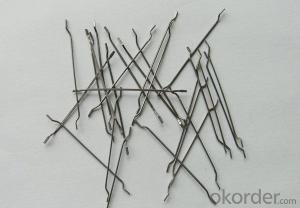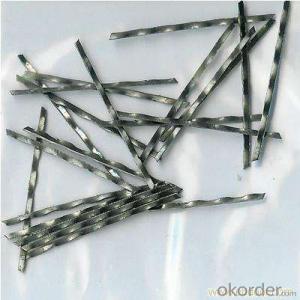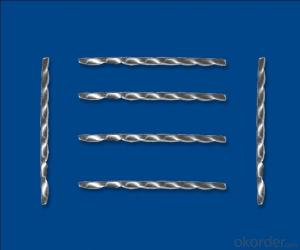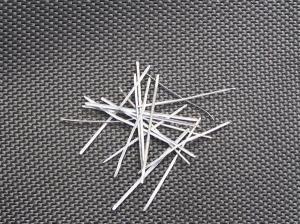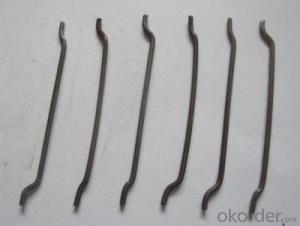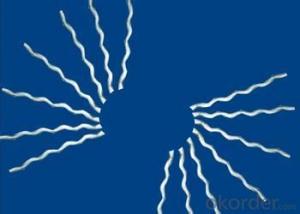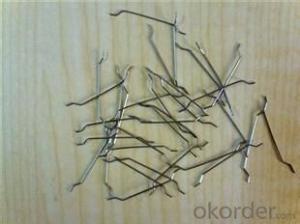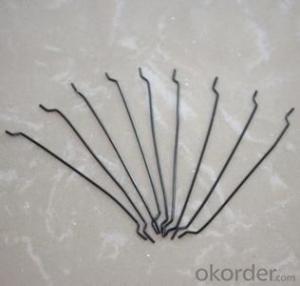Steel Fiber Straight Type CNBM International China
- Loading Port:
- Tianjin
- Payment Terms:
- TT OR LC
- Min Order Qty:
- 1000 kg
- Supply Capability:
- 30000 kg/month
OKorder Service Pledge
OKorder Financial Service
You Might Also Like
Quick Details
Place of Origin: Jiangsu, China (Mainland)
Model Number: HT-ST
Material: Steel
Specifications
The raw material is stainless steel ingots, using electric stoves which melt the stainless steel ingots to become 1500 ~ 1600 ℃ steel liquid, and then with a grooved high speed rotating melt-extracting steel wheel which produces wires that meets are our customers’ specific requirements. When melting down to a wheel steel liquid surface, the liquid steel blow out by slot with centrifugal force at extremely high speed with cooling forming. Melting wheels with water keep the cooling speed. This method is done to produce different material, different sizes of steel fiber.
| SIZE | CHEMIC ELEMENT(%) | ||||||
| C | P | Mn | Si | Cr | Ni | Al | |
| AISI330 | ≤0.40 | ≤0.04 | ≤2.00 | ≤0.75 | 17~20 | 33~37 | |
| AISI310 | ≤0.40 | ≤0.04 | ≤2.00 | ≤1.50 | 24~26 | 19~22 | |
| AISI316 | ≤0.40 | ≤0.04 | ≤2.00 | ≤1.00 | 16~18 | 10~14 | |
| AISI314 | ≤0.40 | ≤0.045 | ≤2.00 | 1.5-3.0 | 23~26 | 19~22 | |
| AISI309 | ≤0.40 | ≤0.04 | ≤2.00 | ≤1.00 | 22~24 | 12~15 | |
| AISI304 | ≤0.40 | ≤0.04 | ≤2.00 | ≤2.00 | 18~20 | 8~10 | |
| AISI301 | ≤0.40 | ≤0.04 | ≤2.00 | ≤2.00 | 16~18 | 6~8 | |
| AISI201 | ≤0.40 | ≤0.06 | 5.5~7.5 | ≤1.00 | 16~18 | 3.5~5.5 | |
| AISI446 | ≤0.40 | ≤0.04 | ≤1.50 | ≤2.00 | 23~27 | ||
| AISI430 | ≤0.40 | ≤0.03 | ≤1.00 | ≤2.00 | 16~18 | ||
| NAS430A | ≤0.40 | ≤0.03 | ≤0.50 | ≤0.50 | 16~18 | 2~4 | |
| SIZE(mm) | ||||
| length | 20 | 25 | 30 | 35 |
| width | 0.75~1.5 | 0.75~1.5 | 0.75~1.5 | 0.75~1.5 |
| thickness | 0.2~0.75 | 0.2~0.75 | 0.2~0.75 | 0.2~0.75 |
Picture
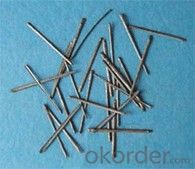
Steel fiber straight type


FAQ
certificated: ISO 9001
Technical advantages of Daye steel fiber:
A. Improve mechanical performance of concrete
B. Provide uniform distribution throughout concrete with excellent mixing
C. No balling or caking by adopt correct mixing method
- Q:How does melt extract stainless steel fiber affect the resistance of concrete to carbonation?
- The resistance of concrete to carbonation can be significantly improved through the use of melt extract stainless steel fiber. Carbonation arises when calcium hydroxide in the concrete reacts with carbon dioxide from the atmosphere, resulting in the formation of calcium carbonate. This process diminishes the alkalinity of the concrete, leading to a decline in its durability and strength. By incorporating stainless steel fibers into the concrete mixture, the carbonation process can be mitigated. These fibers serve as a physical barrier, preventing the entry of carbon dioxide into the concrete matrix. This barrier effect proves particularly effective in reducing the depth of carbonation, which is vital for maintaining the long-term endurance of concrete structures. Moreover, stainless steel fibers enhance the mechanical properties of the concrete. They elevate its tensile strength and ductility, rendering it more resistant to cracking and subsequent carbonation. Additionally, the fibers improve the bond between the cement paste and the aggregates, further bolstering the durability of the concrete. To sum up, the addition of melt extract stainless steel fiber to concrete substantially enhances its resistance to carbonation. It acts as a barrier against the ingress of carbon dioxide, diminishes the depth of carbonation, improves mechanical properties, and ultimately extends the service life of concrete structures.
- Q:Is melt extract stainless steel fiber suitable for use in self-compacting concrete?
- Yes, melt extract stainless steel fiber is suitable for use in self-compacting concrete. This type of fiber is known for its excellent corrosion resistance and high tensile strength, making it ideal for reinforcing self-compacting concrete. The fibers can effectively improve the mechanical properties of the concrete, including its flexural and tensile strength, as well as its resistance to cracking and impact. Additionally, melt extract stainless steel fibers have a high aspect ratio, which helps to enhance the cohesion and homogeneity of the concrete mixture. Overall, using melt extract stainless steel fiber in self-compacting concrete can result in a more durable and robust material, making it suitable for various construction applications.
- Q:Can melt extract stainless steel fiber be used in architectural facades or cladding systems?
- Yes, melt extract stainless steel fiber can be used in architectural facades or cladding systems. This type of fiber is specifically designed to enhance the strength and durability of concrete and other construction materials. It can be incorporated into the facade or cladding system to improve its structural integrity and resistance to cracking or deformation. Additionally, stainless steel fiber is highly resistant to corrosion, making it suitable for outdoor applications where it will be exposed to various weather conditions. Its versatility and ability to enhance the performance of architectural elements make melt extract stainless steel fiber a viable option for architectural facades or cladding systems.
- Q:Can melt extract stainless steel fiber be easily dispersed in concrete mixtures?
- Yes, melt extract stainless steel fiber can be easily dispersed in concrete mixtures. The fine and uniform nature of these fibers allows for easier mixing and distribution within the concrete matrix. Additionally, the high aspect ratio of the fibers enhances their ability to interlock with the concrete, thereby improving its mechanical properties such as tensile strength and crack resistance. The integration of melt extract stainless steel fibers in concrete mixtures can effectively enhance the overall performance and durability of the concrete.
- Q:Can melt extract stainless steel fiber enhance the resistance of concrete to acid attack?
- The resistance of concrete to acid attack can be enhanced by melt extract stainless steel fiber. Renowned for their high corrosion resistance and durability, stainless steel fibers form a network within the concrete that enhances its strength and performance. Concrete is prone to deterioration and damage when exposed to acid attack. Acids react with the calcium hydroxide in the cement paste, causing the dissolution of the concrete matrix and a decrease in its strength. However, the incorporation of stainless steel fibers into the concrete mix creates a barrier that prevents direct contact between the acid and the cement paste. The stainless steel fibers act as reinforcement, improving the mechanical properties of the concrete. They provide extra strength and toughness, increasing its resistance to acid attack. Furthermore, the fibers contribute to stress distribution and reduce crack formation, further safeguarding the concrete against acid penetration. Moreover, the corrosion resistance of stainless steel fibers ensures their integrity even in harsh environments. As a result, they can continue to reinforce and protect the concrete for an extended period. In summary, melt extract stainless steel fiber significantly enhances the resistance of concrete to acid attack. It reinforces the material, prevents direct contact between acids and the cement paste, and improves the durability of the concrete.
- Q:What is the effect of melt extract stainless steel fiber on the fatigue resistance of concrete?
- The addition of melt extract stainless steel fiber to concrete can significantly enhance its fatigue resistance. Stainless steel fibers are known for their high tensile strength and durability, making them ideal for improving the performance of concrete in fatigue-prone applications. The primary effect of melt extract stainless steel fiber on the fatigue resistance of concrete is the reinforcement it provides. These fibers act as a distributed network within the concrete matrix, effectively bridging cracks that may occur under cyclic loading. By preventing crack propagation and reducing crack width, the presence of stainless steel fibers improves the overall fatigue strength of the concrete. Additionally, the high ductility and corrosion resistance of stainless steel fibers contribute to the enhanced fatigue resistance of concrete. The fibers are capable of absorbing and redistributing stress energy, thereby reducing the concentration of stress at localized areas. This ability to dissipate energy helps in preventing the initiation and growth of cracks, ultimately improving the fatigue performance of the concrete. Furthermore, the addition of melt extract stainless steel fiber can also improve the overall toughness and durability of concrete. The fibers increase the resistance to impact and dynamic loading, making the concrete more resistant to fatigue failure. This is particularly beneficial in structures subjected to repetitive loading, such as bridges, pavements, and industrial floors. In summary, the incorporation of melt extract stainless steel fiber in concrete significantly enhances its fatigue resistance. The reinforcement provided by these fibers, along with their high ductility and corrosion resistance, improves crack bridging, reduces crack width, and enhances the overall toughness of the concrete. As a result, structures reinforced with stainless steel fibers exhibit improved durability and extended service life, making them ideal for fatigue-prone applications.
- Q:How does melt extract stainless steel fiber affect the shrinkage and creep of concrete?
- Melt extract stainless steel fiber is commonly used as a reinforcement material in concrete to improve its overall strength and durability. When added to concrete, these fibers provide additional tensile strength and reduce the potential for cracking. In terms of shrinkage, melt extract stainless steel fibers can help minimize the shrinkage of concrete. Shrinkage occurs as water evaporates from the concrete during the curing process, leading to volume reduction. The addition of stainless steel fibers helps to distribute the internal stresses and restrain the shrinkage. This results in reduced shrinkage cracks and an overall decrease in the amount of shrinkage experienced by the concrete. Similarly, when it comes to creep, which is the time-dependent deformation of concrete under sustained load, melt extract stainless steel fibers play a crucial role. Creep occurs due to the ongoing chemical and physical processes within the concrete, causing it to gradually deform over time. The presence of stainless steel fibers in the concrete helps to control this creep deformation by providing additional resistance against the applied load. The fibers act as a reinforcement, distributing the stresses and reducing the overall creep strain in the concrete. In summary, the addition of melt extract stainless steel fiber to concrete significantly affects the shrinkage and creep properties. It helps to minimize shrinkage by distributing internal stresses and restraining volume reduction. Additionally, it controls creep deformation by providing additional resistance against sustained loads and reducing the overall creep strain. Overall, the presence of stainless steel fibers improves the long-term performance and durability of concrete structures.
- Q:How does melt extract stainless steel fiber improve the durability of fiber-reinforced concrete?
- Melt extract stainless steel fiber, as a highly effective material, significantly enhances the durability of fiber-reinforced concrete. This stainless steel fiber offers several key advantages that contribute to the overall strength and longevity of the concrete. To begin with, the incorporation of melt extract stainless steel fiber improves the crack resistance of fiber-reinforced concrete. These fibers possess high tensile strength and exceptional stress distribution capabilities within the concrete matrix. As a result, they effectively prevent the formation and propagation of cracks, even under heavy loads or extreme temperature fluctuations. By reducing crack occurrence, the overall durability and lifespan of the concrete structure are greatly enhanced. Furthermore, melt extract stainless steel fibers exhibit excellent corrosion resistance properties. Unlike other fiber types, these stainless steel fibers are highly resistant to chemical attacks, moisture, and aggressive substances. This corrosion resistance ensures the structural integrity of the fibers over time, even in harsh environments. Consequently, the concrete reinforced with melt extract stainless steel fibers is better equipped to withstand the deteriorating effects of water, chemicals, and other corrosive elements. In addition, melt extract stainless steel fibers enhance the impact and abrasion resistance of fiber-reinforced concrete. The strong and ductile nature of these fibers enables them to absorb and disperse energy efficiently. This characteristic makes the concrete more resistant to impacts, such as heavy loads or dynamic forces, which can cause cracking or surface damage. By improving the concrete's ability to withstand these external forces, the overall durability of the structure is significantly improved. Moreover, the addition of melt extract stainless steel fiber enhances the overall toughness of fiber-reinforced concrete. These fibers act as reinforcements, providing additional strength and ductility to the concrete matrix. This increased toughness allows the concrete to better resist various forms of loading, including bending, tension, and compression. As a result, the concrete becomes less prone to failure or damage, leading to a longer service life and improved durability. In conclusion, melt extract stainless steel fiber greatly enhances the durability of fiber-reinforced concrete by improving crack resistance, corrosion resistance, impact and abrasion resistance, as well as overall toughness. These fibers reinforce the structure and aid in stress distribution, thereby preventing crack formation and propagation. Moreover, their resistance to corrosion ensures long-term structural integrity, even in challenging environments. The increased impact and abrasion resistance, along with enhanced toughness, make the concrete more resistant to external forces, further improving its durability. Overall, the use of melt extract stainless steel fiber is a highly effective approach to enhance the durability and longevity of fiber-reinforced concrete structures.
- Q:Can melt extract stainless steel fiber be used in high-rise building construction?
- Yes, melt extract stainless steel fiber can be used in high-rise building construction. Stainless steel fibers provide enhanced strength, durability, and corrosion resistance to concrete structures, making them suitable for high-rise buildings that require superior structural integrity and longevity. Additionally, stainless steel fibers can improve the crack resistance and fire resistance of the concrete, further enhancing the safety and performance of the building.
- Q:Can melt extract stainless steel fiber be used in foundation slabs?
- Yes, melt extract stainless steel fiber can be used in foundation slabs. These fibers provide reinforcement and improve the overall strength and durability of the slab. They help to reduce cracking and increase the load-bearing capacity of the foundation, making it a suitable choice for construction projects.
1. Manufacturer Overview |
|
|---|---|
| Location | |
| Year Established | |
| Annual Output Value | |
| Main Markets | |
| Company Certifications | |
2. Manufacturer Certificates |
|
|---|---|
| a) Certification Name | |
| Range | |
| Reference | |
| Validity Period | |
3. Manufacturer Capability |
|
|---|---|
| a)Trade Capacity | |
| Nearest Port | |
| Export Percentage | |
| No.of Employees in Trade Department | |
| Language Spoken: | |
| b)Factory Information | |
| Factory Size: | |
| No. of Production Lines | |
| Contract Manufacturing | |
| Product Price Range | |
Send your message to us
Steel Fiber Straight Type CNBM International China
- Loading Port:
- Tianjin
- Payment Terms:
- TT OR LC
- Min Order Qty:
- 1000 kg
- Supply Capability:
- 30000 kg/month
OKorder Service Pledge
OKorder Financial Service
Similar products
New products
Hot products
Hot Searches
Related keywords






